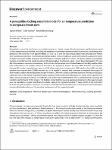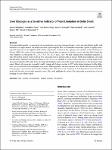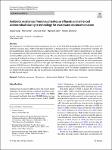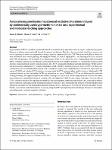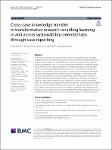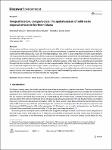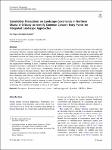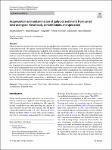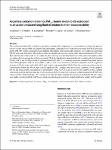Search
Author
- Osman, Ahmed I. (5)
- Chen, Zhonghao (2)
- Ricohermoso III, Emmanuel (2)
- Wang, Yongbin (2)
- next >
Subject
- LCA (6)
- ICP-MS (3)
- Artificial intelligence (2)
- CDW (2)
- next >
Date issued
Has File(s)
- true (220)
Search Results
Bangladesh is one of the world’s most susceptible countries to climate change. Global warming has significantly increased surface temperatures worldwide, including in Bangladesh. According to meteorological observations, the average temperature of the world has risen approximately 1.2 °C to 1.3 °C over the last century. Researchers and decision-makers have recently paid attention into the climate change studies. Climate models are used extensively throughout the nation in studies on global climate change to determine future estimates and uncertainties. This paper outlines a perceptible stacking ensemble learning model to estimate the temperature of a tropical region—Cox’s Bazar, Bangladesh. |
Assessing habitat quality is a major goal of conservationists and restoration practitioners, but to associate habitat quality with biomarkers of vagile animals, the biomarkers must respond rapidly. Here, we identified a biomarker capable of rapidly detecting food limitation in the imperiled Delta Smelt (Hypomesus transpacificus), a pelagic fish endemic to the San Francisco Estuary (SFE). We conducted an experiment with fed and unfed treatments of hatchery-raised, sub-adult Delta Smelt that were sampled at 12 time points: 0, 1, 2, 3, 4, 5, 6, 7, 9, 11, 14, and 21 days. We then compared four biomarkers using Day 21 fish: RNA/DNA in liver, triglycerides in liver, glycogen in liver, and glycogen in muscle. Of the liver endpoints, glycogen had the largest difference between treatments at... |
The frequencies of 6 different facultative pathogenic bacteria of the ESKAPE group (priority list WHO) and a total of 14 antibiotic resistance genes (ARGs) with different priorities for human medicine were quantified in wastewaters of poultry and pig slaughterhouses using molecular biological approaches. Raw sewage from poultry and pig slaughterhouses was found to be contaminated not only with facultative pathogenic bacteria but also with various categories of clinically relevant ARGs, including ARGs against the reserve antibiotics group. The concentration of the different gene targets decreased after on-site conventional biological or advanced oxidative wastewater treatments, but was not eliminated. Hence, the antimicrobial BlueLight (aBL) in combination with a porphyrin photo-sens... |
Cypermethrin (CYP) is a synthetic pyrethroid utilized as an insecticide in agriculture and various pest eradication programs. However, it induces numerous health hazards for animals and humans. Therefore, the current study used Panax ginseng root extract (ginseng) to reduce the hepatorenal damage caused by commercially used CYP. Thirty-two male Wistar albino rats were distributed into control, ginseng (300 mg/kg B.W/day), CYP (4.67 mg/kg B.W.), and Ginseng+CYP (rats received both CYP and ginseng). All treatments were administered orally for 30 consecutive days. Cypermethrin induced harmful effects on hepatic and renal tissues through a substantial decline in body weight in addition to a considerable increase in liver enzymes, functional renal markers, and cholesterol. Also, CYP sign... |
The field of transdisciplinary sustainability research has brought forward a number of approaches aimed at fostering sustainability transformations and generating knowledge through collaborative experimentation in real-world settings. These cases are strongly embedded in their local context and thus the transfer of knowledge remains a key challenge. In this paper, we propose a case reporting approach that supports the structured and coherent reporting of such cases. This scheme is aimed at sustainability-oriented labs, where sustainability solutions are collaboratively developed through experimentation. The scheme focuses the reporting on local contexts, lab processes, and experiments. It is accompanied by a logic model and a set of four principles guiding the reporting procedure. T... |
Urban centres in Ghana continue to expand to areas with difficult accessibility, severely impacting location decisions on solid waste disposal sites (SWDS). This study uses the location theory to examine the spatial distribution of SWDS in urban Ghana. Methodologically, it uses the nearness neighbour tool, which is a key component in GIS for spatial analysis. The results show that the distribution of SWDS was clustered, randomized, and skewed. The distribution was influenced by accessibility and the ability to pay for waste management services. For these reasons, high-density populated communities were serviced through the central container collection system, while high-class residential areas benefited through the door-to-door collection system |
Urban stormwater typically enters sewer networks through gully pots, which allow a primary sedimentation of solids upstream of the piped network. The regular removal and disposal of retained sediment are necessary, costly and can involve environmental risks due to the contamination of sediments with substances from the urban environment such as metals. The concentrations and speciation of Cd, Cr, Cu, Ni, Pb and Zn were analysed in sediments from 26 gully pots located in different land use areas in Stockholm, Sweden. In addition, accumulation rates of both sediment and metal masses were evaluated, providing a basis for optimising maintenance practices and better understanding of impacts of characteristic urban land use types. Metal concentrations varied by at most a factor of eight b... |
The oxidative potential (OP) is defined as the ability of inhaled PM components to catalytically/non-catalytically generate reactive oxygen species (ROS) and deplete lung antioxidants. Although several studies have measured the OP of particulate matter (PM OP) soluble components using different antioxidants under neutral pH conditions, few studies have measured PM OP with acidic lung fluids. This study provides new insights into the use of acidic rather than neutral fluids in OP assays. Thus, the first aim of this study was to clarify the effect of using an acidic lung fluid on ascorbic acid (AA) depletion. This was achieved by measuring the oxidative potential (OP-AA) of individual compounds known to catalyze the AA oxidation (CuSO4, CuCl2, and 1,4-NQ) in artificial lysosomal fluid... |
In recent years, the European Union has made sustainable consumption and production a political priority, to address economic and social development within the capacity of the ecosystem. To this end, it has put in place several actions related to resource efficiency, energy taxation and the promotion of renewable energies. This has been positive in terms of production, but less progress has been achieved in consumption. Greater understanding of the factors that influence sustainable energy consumption is particularly important. This paper investigates the effects of energy demand policies (energy taxes) and energy supply policies (renewable energies development, competitive energy markets and eco-innovation) on sustainable energy consumption in the EU-28 from 2008 to 2019. |

